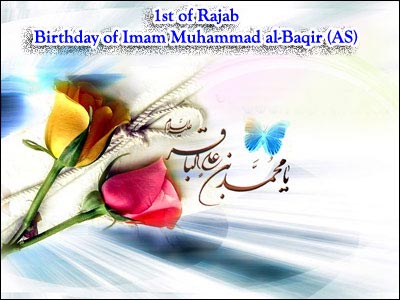
Dr.Mazhar Naqvi
The first day of Islamic month Rajab also marks the birth
anniversary of fifth Imam Muhammad Baqir(Baqar).Also called Abu Jafar and known as al-Baqir( the one who opens knowledge) his full
name was Muhammad bin 'Ali
bin al-Husain bin Ali bin Abi Talib. His father was Imam Zain -ul- Abdeen and he was succeeded by his son Jafar
Sadiq as the 6th Imam. He was the first Imam descended from both
grandsons of Holy Prophet Muhammad
i.e. Hasan Ibn Ali and Hussain ibn Ali He is revered by Muslims for his religious
leadership, and respected for his knowledge and Islamic scholarship as a jurist
in Medina .He was born in
Medina around 56 AH and was
present at battle of Karbala in 61 Hijri as a four year old child.
Imamis believe that the title of fifth Imam Baqir al- ilm was
not an ordinary one, for it was given to him by the Holy Prophet. According
to al -Kulyani, Prophet’s
only living companion Jabir would
sit in the mosque and cry: "Ya
baqir al-ilm, Ya baqir al-ilm". Although Medinians thought that Jabir was
insane, he assured them that Prophet had told him: "O Jabir! You will meet
a man from my family who will have the same name and the same characteristics
as mine. He will split open knowledge extensively.al-Kulyani further records
that Jabir met al-Baqir when passing a Quran school. He saw that the imam was
still a child, and examined him to see if he had the features of the Holy
Prophet. Jabir approached him, kissed
his head and swore by his father and mother that Prophet had sent greeting
upon him.
Imam Baqar led a life fully dedicated to scholarly pursuits and led
the community carefully against a hostile regime. His sayings are pearls of wisdom
for the whole mankind. People can lead a meaningful and purposeful life by
following the maxims given by the fifth Imam. Some of his quotes relating to
the betterment of human beings are being reproduced so as to enable people make
the world a better place to live in. This will also be a befitting manner to
recall him on his birth anniversary.
·
“One
who does not cultivate patience for confronting the troubles of life becomes
weak.”
·
“When
you hear knowledge, then put it into effect. Let your hearts be wide. For the
person with the heart that does not encompass his abundant knowledge makes
Satan powerful over him. If Satan disputed with you, then dispute with him
through what you know.”
- · The height of perfection is excellence in the understanding of the religion, endurance in hardships and administration of the affairs of life according to one's means, in the right measure.
- · I admonish you regarding five things; if you are wronged, do not commit wrong doing to others, if you are betrayed, do not betray anyone, if you are called a liar, do not be furious, if you are praised, do not be jubilant, if you are criticized do not fret and think of what is said in criticism, if you find in yourself what is criticized about you, then you are falling down in the eyes of God; when you are furious about the truth, it is much greater calamity then your falling down in the eyes of the people. And if you are opposite of what is said (in criticism) about you, then it is a merit you acquired without having to tire yourself in obtaining it.
- · The scholar who derives benefit from his knowledge is better than 70,000 devotees.
- · "Indeed if you are good in teaching the people and do not show pride towards them, then Allah will increase you from His favor. However if you prevent them from learning your knowledge, then it is incumbent upon Allah, the Great and Almighty, to deprive you of knowledge and its splendor and to drop your position from the hearts of people."
- · "I hate the person who is jobless and who merely lies on his back and says, 'O Allah! Give me sustenance! He asks Allah to do him a favor while the small ant comes out of its ant colony to seek its livelihood!"
- · A man giving in alms one piece of silver in his lifetime is better for him than giving one hundred when about to die
- · Nobody remains safe from sin unless he guards his tongue.
- · The one who remains patient over its unpleasantness in the world enters the paradise.(References available on request. Photo Courtesy Google Images )













